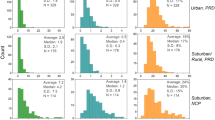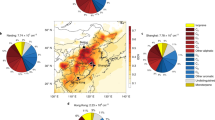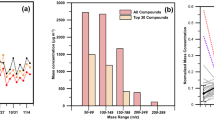Abstract
Volatile organic compounds play a central role in the processes that generate both urban photochemical smog and tropospheric ozone1,2. For successful and accurate prediction of these pollution episodes, identification of the dominant reactive species within the volatile organic carbon pool is needed3. At present, lack of resolution inherent in single-column chromatographic analysis4 limits such a detailed chemical characterization of the complex urban atmosphere. Here we present an improved method of peak deconvolution from double-column (orthogonal) gas chromatography5,6. This has enabled us to isolate and classify more than 500 chemical species of volatile organic compounds in urban air, including over 100 multi-substituted monoaromatic and volatile oxygenated hydrocarbons. We suggest that previous assessments of reactive carbon species may therefore have underestimated the contribution made by volatile organic compounds to urban pollution, particularly for compounds with more than six carbon atoms. Incorporating these species in predictive models should greatly improve our understanding of photochemical ozone yields and the formation of harmful secondary organic aerosols7,8.
This is a preview of subscription content, access via your institution
Access options
Subscribe to this journal
Receive 51 print issues and online access
$199.00 per year
only $3.90 per issue
Buy this article
- Purchase on Springer Link
- Instant access to full article PDF
Prices may be subject to local taxes which are calculated during checkout




Similar content being viewed by others
References
Fowler, D. et al. Fourth Report of the Photochemical Oxidants Review Group 75–104 (United Kingdom Department of the Environment, Transport and the Regions, London, 1997).
Madronich, S. & Calvert, J. G. Permutation reactions of organic peroxy-radicals in the troposphere. J. Geophys. Res. 95, 5697 (1990).
Houweling, S., Dentener, F. & Lelieveld, J. The impact of non-methane hydrocarbons on tropospheric photochemistry. J. Geophys. Res. 103, 10673 –10696 (1998).
Giddings, J. C. in Multidimentional Chromatography: Techniques and Applications (ed. Cortes, H. J.) 1–27 (Marcel Dekker, New York, 1990).
Bushey, M. M. & Jorgenson, J. W. Automated instrumentation for comprehensive two dimensional high performance liquid chromatography—capillary zone electrophoresis. Anal. Chem. 62, 978 –984 (1990).
Liu, Z. & Phillips, J. B. Comprehensive two-dimensional gas-chromatography using an on-column thermal modulator interface. J. Chromatogr. Sci. 29, 227–231 (1991).
Derwent, R. G., Jenkin, M. E., Saunders, S. M. & Pilling, M. J. Photochemical ozone creation potentials for organic compounds in northwest Europe calculated with a master chemical mechanism. Atmos. Environ. 32, 2429–2441 ( 1998).
Forstner, H. L., Flagan, R. C. & Seinfeld, J. H. Secondary aerosol from the photo-oxidation of aromatic hydrocarbons: molecular composition. Environ. Sci. Technol. 21, 1345–1358 (1997).
Carter, W. P. L. Development of ozone reactivity scales for volatile organic compounds. J. Air Waste Manag. Assoc. 44, 881– 899 (1994).
Lewis, A. C. et al. Atmospheric monitoring of volatile organic compounds using programmed temperature vaporisation injection. J. High Res. Chromatogr. 19, 686–690 ( 1996).
McMinn, D. G. & Hill, H. H. in Detectors for Capillary Chromatography (eds Hill, H. H. & McMinn, D. G.) 15– 17 (Wiley, New York, 1992).
Gaines, R. B., Frysinger, G. S., Hendrick Smith, M. S. & Stuart, J. D. Oil spill source identification by comprehensive two-dimensional gas chromatography. Environ. Sci. Technol. 33, 2106– 2112 (1999).
Air Emissions Inventory Port Phillip Region 4–25 (Australian Environmental Protection Authority, Melbourne, 1998).
Duffy, B. L., Nelson, P. F., Ye, Y., Weeks, I. A. & Galbally, I. E. Emissions of benzene, toluene, xylenes and 1,3-butadiene from a representative portion of the Australian car fleet. Atmos. Environ. 32, 2693–2704 ( 1998).
Carter, W. P. L. A detailed mechanism for the gas-phase atmospheric reactions of organic compounds. Atmos. Environ. A 24, 481– 518 (1990).
Stockwell, W. R., Kirchner, F., Kuhn, M. & Seefeld, S. A new mechanism for regional atmospheric chemistry modelling. J. Geophys. Res. 102, 25847–25879 ( 1997).
Carslaw, N. et al. Modelling OH, HO2 and RO2 radicals in the marine boundary layer: 1. Model construction and comparison with measurements. J. Geophys. Res. 104, 30241– 30255 (1999).
McKeen, S. A. et al. Photochemical modeling of hydroxyl and its relationship to other species during the tropospheric OH photochemistry experiment. J. Geophys. Res. 102, 6467–6493 (1997).
Venkatramani, C. J. & Phillips, J. B. Comprehensive two-dimensional gas-chromatography applied to the analysis of complex-mixtures. J. Microcolumn Separat. 5, 511– 516 (1993).
Kinghorn, R. M. & Marriott, P. J. Comprehensive gas chromatography using a modulating cryogenic trap. J. High Resol. Chromatogr. 21, 620–622 (1998).
Kinghorn, R. M. & Marriott, P. J. Modulation and manipulation of chromatographic bands by using thermal means. Anal. Sci. 14, 651–660 ( 1998).
Acknowledgements
We thank the UK Engineering and Physical Sciences Research Council and the UK Department of the Environment, Transport and the Regions for financial support. We also acknowledge the support of Hewlett-Packard (Australia), and SGE International (Australia).
Author information
Authors and Affiliations
Corresponding author
Rights and permissions
About this article
Cite this article
Lewis, A., Carslaw, N., Marriott, P. et al. A larger pool of ozone-forming carbon compounds in urban atmospheres . Nature 405, 778–781 (2000). https://doi.org/10.1038/35015540
Received:
Accepted:
Issue Date:
DOI: https://doi.org/10.1038/35015540
This article is cited by
-
Oceanic phytoplankton are a potentially important source of benzenoids to the remote marine atmosphere
Communications Earth & Environment (2021)
-
Atmospheric insight into the reaction mechanism and kinetics of isopropenyl methyl ether (i-PME) initiated by OH radicals and subsequent oxidation of product radicals
Environmental Science and Pollution Research (2021)
-
The effects of dopant on catalytic activity of Pd/mesoporous alumina for toluene oxidation
Research on Chemical Intermediates (2021)
-
Assessment of polar organic aerosols at a regional background site in southern Africa
Journal of Atmospheric Chemistry (2019)
-
Investigation of synergistic effects and high performance of La-Co composite oxides for toluene catalytic oxidation at low temperature
Environmental Science and Pollution Research (2019)
Comments
By submitting a comment you agree to abide by our Terms and Community Guidelines. If you find something abusive or that does not comply with our terms or guidelines please flag it as inappropriate.



